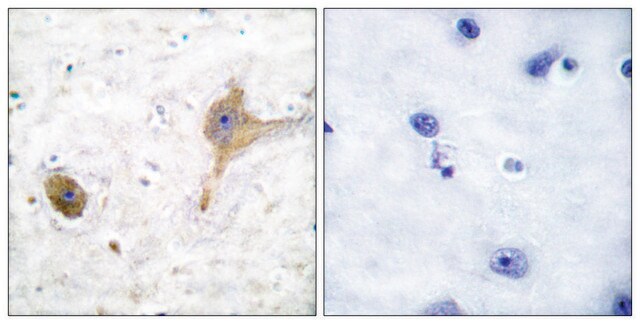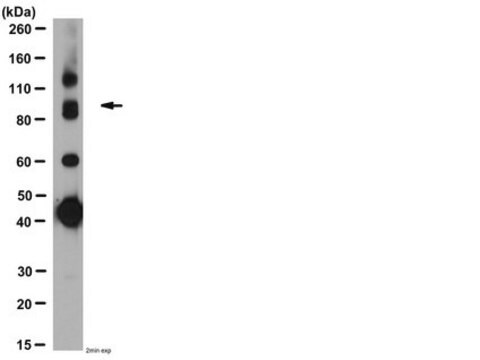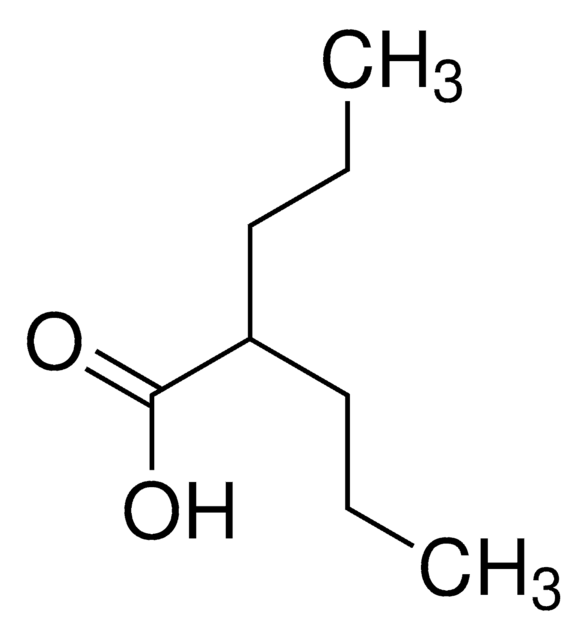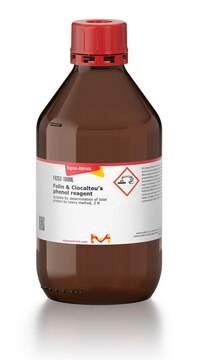G9920
Anti-GABAB Receptor 2 antibody produced in rabbit
affinity isolated antibody, lyophilized powder
Synonym(s):
Anti-γ-Aminobutyric acid receptor type B subunit 2, Anti-GABABR2
Sign Into View Organizational & Contract Pricing
All Photos(2)
About This Item
Recommended Products
biological source
rabbit
Quality Level
conjugate
unconjugated
antibody form
affinity isolated antibody
antibody product type
primary antibodies
clone
polyclonal
form
lyophilized powder
species reactivity
rat
technique(s)
western blot: 1:200 using rat brain membranes
UniProt accession no.
shipped in
dry ice
storage temp.
−20°C
target post-translational modification
unmodified
Gene Information
rat ... Gabbr2(83633)
Related Categories
General description
The GABAB receptor (GABABR) is a heteromeric G-protein-coupled receptor. It has two subunits-GABAB1 (γ-aminobutyric acid type B receptor subunit 1) and GABAB2 (γ-aminobutyric acid type B receptor subunit 2). In the hippocampus, GABAB2 is present in dendrites and located in the extra-synaptic membrane of spines and dendritic shafts. This gene is located on rat chromosome 5q.
Immunogen
peptide CKDPIEDINSPEHIQRRLSL corresponding to residues 875-894 of human GABABR2.
Application
Anti-GABAB Receptor 2 antibody produced in rabbit is suitable for western blotting at a working dilution of 1:200 using rat brain membranes.
Anti-GABAB Receptor 2 antibody has been used in western blotting.
Applications in which this antibody has been used successfully, and the associated peer-reviewed papers, are given below.
Western Blotting (1 paper)
Western Blotting (1 paper)
Biochem/physiol Actions
The inhibitory neurotransmitter GABA signals through two distinct types of pre- and postsynaptic receptors, GABAA and GABAB. Both GABA receptors can regulate depression of synaptic transmission and be involved in the inhibition controlling neuronal excitability. The GABA transmitter interacts with three types of receptors: the ionotropic receptors GABAA and GABAC and the metabotropic GABAB receptor (GABABR). GABABR is a G-protein coupled receptor that plays a key role in slow synaptic inhibition in the brain and spinal cord. GABABR is a heteromer with two subunits, GABABR1 and GABABR2. The amino acids within the second intracellular domain of GABA(B2) are essential for the coupling of GABA(B) receptor heterodimers to their downstream effector systems. The N-termini on both the GB1 and GB2 receptors are involved in the normal coupling of GABAB receptors to their physiological effectors, G(i) and G-protein-activated potassium channels (GIRKs).
Target description
The GABABR2 was shown to be essential for trafficking and G-protein binding, while the GABAB R1 subunit was demonstrated to be important for agonist and antagonist binding. GABABR2 is highly expressed in brain especially at the cerebral cortex, thalamus, hippocampus, and spinal cord and to a lesser extent in testis.
Physical form
Lyophilized from phosphate buffered saline, pH 7.4, containing 1% BSA and 0.05% sodium azide.
Reconstitution
Reconstitute the lyophilized vial with 50 μL or 200 μL deionized water, depending on package size. Further dilutions should be made using a carrier protein such as BSA (1-3%).
Disclaimer
Unless otherwise stated in our catalog or other company documentation accompanying the product(s), our products are intended for research use only and are not to be used for any other purpose, which includes but is not limited to, unauthorized commercial uses, in vitro diagnostic uses, ex vivo or in vivo therapeutic uses or any type of consumption or application to humans or animals.
Not finding the right product?
Try our Product Selector Tool.
Storage Class Code
11 - Combustible Solids
WGK
WGK 2
Flash Point(F)
Not applicable
Flash Point(C)
Not applicable
Choose from one of the most recent versions:
Already Own This Product?
Find documentation for the products that you have recently purchased in the Document Library.
M Margeta-Mitrovic et al.
Proceedings of the National Academy of Sciences of the United States of America, 98(25), 14649-14654 (2001-11-29)
Many G protein-coupled receptors (GPCRs) have recently been shown to dimerize, and it was suggested that dimerization may be a prerequisite for G protein coupling. gamma-aminobutyric acid type B (GABA(B)) receptors (GPCRs for GABA, a major inhibitory neurotransmitter in the
Yinghui Guo et al.
Experimental and therapeutic medicine, 9(4), 1448-1454 (2015-03-18)
The aim of the present study was to investigate the genes associated with 'anger-in' (tendency to suppress anger) and 'anger-out' (tendency to express anger through verbal or physical means) emotions in humans. Wistar rats were divided into five groups (n=10/group)
Mathias Boller et al.
Journal of neurophysiology, 89(4), 2035-2045 (2003-04-11)
In mammals, GABA(C) receptors seem to be specifically expressed in the retina and the subcortical visual system, with highest extraretinal expression levels in the superior colliculus (SC). Although its presence in the superficial SC has been demonstrated physiologically, a direct
M Margeta-Mitrovic et al.
Proceedings of the National Academy of Sciences of the United States of America, 98(25), 14643-14648 (2001-11-29)
gamma-aminobutyric acid type B (GABA(B)) receptors, G protein-coupled receptors (GPCRs) for GABA, are obligate heterodimers of two homologous subunits, GB1 and GB2. Typical for family C GPCRs, the N termini of both GB1 and GB2 contain a domain with homology
M J Robbins et al.
The Journal of neuroscience : the official journal of the Society for Neuroscience, 21(20), 8043-8052 (2001-10-06)
GABA(B) receptors are unique among G-protein-coupled receptors (GPCRs) in their requirement for heterodimerization between two homologous subunits, GABA(B1) and GABA(B2), for functional expression. Whereas GABA(B1) is capable of binding receptor agonists and antagonists, the role of each GABA(B) subunit in
Our team of scientists has experience in all areas of research including Life Science, Material Science, Chemical Synthesis, Chromatography, Analytical and many others.
Contact Technical Service








